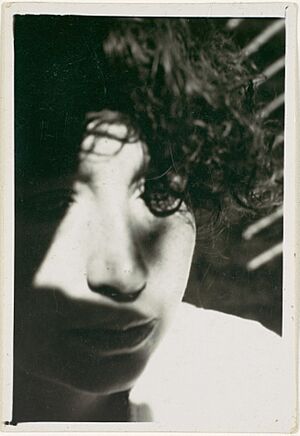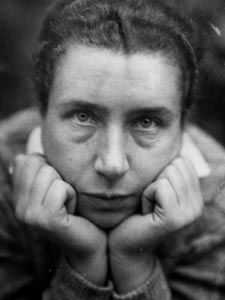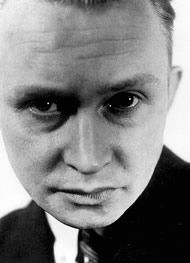Lucia Moholy facts for kids
Lucia Moholy (born Lucia Schulz; 18 January 1894 – 17 May 1989) was a talented photographer and editor. She took many important pictures of the buildings and designs from the famous Bauhaus art school. Her photos helped people around the world learn about Bauhaus ideas after World War II. Sadly, Lucia Moholy was often not given credit for her amazing work. Her photos were sometimes said to be taken by her husband, László Moholy-Nagy, or by Walter Gropius.
Contents
Early Life and Education
Lucia Schulz grew up in Prague, which was part of Austria-Hungary at the time. Her father was a lawyer. From her diaries, we know she wrote to pen pals in the United States in English. She also enjoyed reading books by famous authors like Thomas Mann and Leo Tolstoy.
In 1912, Lucia became a qualified teacher of German and English. After that, she studied philosophy, philology (the study of language), and art history at the University of Prague.
Starting Her Career
During the early years of World War I, Lucia Schulz started working as a theater critic for a newspaper in Wiesbaden, Germany. Soon after, she moved to Leipzig. In Berlin, she worked for publishing companies, helping to edit and prepare books.
In 1919, she even published some creative writings herself. She used the pen name "Ulrich Steffen" for these works.
Personal Life and Challenges

In April 1920, Lucia met László Moholy-Nagy in Berlin. He was an artist who had recently moved from Hungary. They got married on her 27th birthday, January 21, 1921. Lucia worked for publishing houses and was the main person earning money for the couple.
They later lived in Dessau, Germany, on the campus of the Bauhaus school. Lucia's diaries show she sometimes felt unhappy there and missed city life. She and László separated in 1929.
In 1933, the Nazi Party came to power in Germany. Lucia had to leave Berlin suddenly, leaving behind all her belongings. This included her large glass negatives of the Bauhaus photographs. These negatives ended up with Walter Gropius. She first went to Prague to stay with her family, then to Switzerland, Austria, and Paris, before finally settling in London.
After World War II, Lucia tried to move to the United States. Her application was denied in 1940 because she was told she didn't have enough teaching experience.
Her Time at the Bauhaus (1923-1928)
In 1923, Walter Gropius, who started the Bauhaus school, hired László Moholy-Nagy as a teacher. In 1926, Lucia and László moved into one of the special 'Meisterhäuser' (Masters' Houses) on the school's new campus in Dessau, Germany.
For five years, Lucia took many photos of the Bauhaus. She photographed the buildings, both inside and out, and also the students and teachers. Her style was part of a movement called Neue Sachlichkeit (New Objectivity). This style focused on taking clear, direct pictures. Lucia's photos helped create the famous look and identity of the Bauhaus school. She was a very skilled photographer, having studied at the Leipzig Academy for Graphic and Book Arts. She also learned a lot at Otto Eckner’s photography studio.
Lucia and László also experimented together in the darkroom, creating things like photograms (pictures made without a camera).
The Struggle for Recognition
In 1925, a book called Malerei, Photografie, Film (Painting, Photography, Film) was published. Even though Lucia had contributed to the experiments in the book, only László Moholy-Nagy's name was on it. This was a common problem for her.
In 1938, while Lucia was living in London, Walter Gropius used about fifty of her Bauhaus images for an exhibition at the Museum of Modern Art (MoMA) in New York. He also used them in the exhibition's catalog. He did not give her any credit for her work.
Lucia Moholy worked hard to get credit for her photographs. Her images were used a lot for marketing the Bauhaus school and in its sales catalogs. She also edited books published by Bauhaus that featured her photos. As interest in the Bauhaus grew, she saw many catalogs printed with her lost images. Gropius kept using her photos without giving her credit. She tried many times to get her negatives back from him, but he refused. Lucia even had to hire a lawyer to try and get her work returned.
Letters between Walter Gropius and Lucia Moholy show how she fought for her work. She wrote, "These negatives are irreplaceable documents which could be extremely useful, now more than ever." Gropius replied that she had given them to him and that he found them "extremely useful." Lucia reminded him of their friendship, saying, "No formal agreement could have carried more weight than our friendship."
Lucia did not get her original negatives back until 1957. Even then, she only got some of them – 230 out of 560 Bauhaus-era negatives were returned. The rest are still missing. In 1972, she published Moholy-Nagy Notes to try and get credit for her work that had been used without her permission. After she passed away, her collection of negatives was given to the Bauhaus Archive in Berlin.
Later Years in London and Switzerland
In London (1933-1959), Lucia Moholy focused on commercial photography and teaching. She also wrote a book called A Hundred Years of Photography, 1839-1939, which discussed the history of photography. She also worked at the London Science Museum Library, helping to create microfilm copies of documents for storage.
From 1946 to 1957, after World War II, she traveled to the Near and Middle East for projects with UNESCO. She worked on photographic reproduction and directed documentary films.
In 1959, she moved to Zollikon, Switzerland. There, she wrote about her experiences at the Bauhaus and focused on art criticism.
Exhibitions and Publications
In 1925, Lucia Moholy's work was shown in an important exhibition in Stuttgart called Film and Foto. This exhibition featured artists who used the "New Vision" style of photography.
Her photos of the novelist Inez Pearn are kept at the National Portrait Gallery. One of these photos was part of the Bauhaus In Britain exhibition at the Tate Britain in 2019.
In her book, A Hundred Years of Photography, 1839-1939, she explored the history of photography in great detail.
Her 1972 book, Moholy-Nagy Notes, was her way of showing the shared work between herself and László Moholy-Nagy at the Bauhaus. She wanted to make sure she received credit for her photographs and experiments.
See also
 In Spanish: Lucia Moholy para niños
In Spanish: Lucia Moholy para niños
- László Moholy-Nagy (1895-1946)
- Walter Gropius (1883-1969)
- Florence Henri (1893-1982)
- Georg Muche (1895-1987)
- Franz Roh (1890-1965)
- Marianne Brandt (1893-1983)
- Gunta Stölzl (1897-1983)
- Otti Berger (1898-1944/45)
- Grete Stern (1904-1999)
- Bauhaus (1919-1933)



